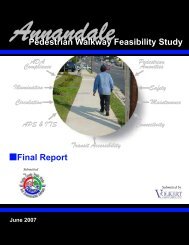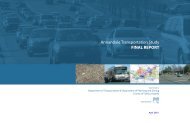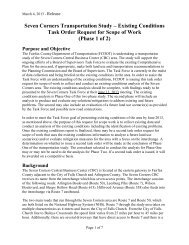2050 Eastern Gateway Concept Plan - City of Falls Church
2050 Eastern Gateway Concept Plan - City of Falls Church
2050 Eastern Gateway Concept Plan - City of Falls Church
Create successful ePaper yourself
Turn your PDF publications into a flip-book with our unique Google optimized e-Paper software.
Size<br />
The approximately 65-acre <strong>Eastern</strong> <strong>Gateway</strong> site includes the<br />
12 acre Oakwood Cemetery and 58 acres, or 2.5 million<br />
square feet, <strong>of</strong> developable land. Table 3.1 on the following<br />
page provides detailed acreage and square footage<br />
information for each parcel within the three areas <strong>of</strong> interest<br />
within the Seven Corners <strong>Gateway</strong> Site and for Oakwood<br />
Cemetery.<br />
History <strong>of</strong> Development<br />
A Sprawling Commercial Center<br />
Though the <strong>City</strong> <strong>of</strong> <strong>Falls</strong> <strong>Church</strong> was established in 1875, it was<br />
around 1948, when <strong>Falls</strong> <strong>Church</strong> became an independent city,<br />
that the <strong>Eastern</strong><br />
<strong>Gateway</strong> began to<br />
develop into what it<br />
is today. As the<br />
Washington, D.C.<br />
metropolitan area<br />
began to expand in<br />
the mid 20th<br />
century, the <strong>City</strong> <strong>of</strong><br />
<strong>Falls</strong> <strong>Church</strong> was<br />
well-positioned to<br />
accommodate the<br />
impending suburban development. Due to its location at the<br />
intersection <strong>of</strong> several major arteries connecting it to<br />
Washington, D.C. to the east and expanding Northern Virginia<br />
development to the west, <strong>Falls</strong> <strong>Church</strong> welcomed its first<br />
suburban-style shopping center in 1953. While the 1953 Seven<br />
Corners Shopping Center is not located within <strong>Falls</strong> <strong>Church</strong>, its<br />
early success encouraged similar suburban development, with<br />
single-use buildings, vast surface parking areas, and limited<br />
access to public transportation, to spring up and spread.<br />
The site and the surrounding areas in Arlington and Fairfax<br />
Counties grew to become the typically auto-oriented mid-20th<br />
century suburban commercial development, where patrons could<br />
conveniently drive their cars directly to strip shopping centers,<br />
car dealerships, and large grocery stores. But in the last<br />
decade, there has been a shift away from suburban autooriented<br />
commercial development in favor <strong>of</strong> more traditional<br />
main street-type development. This has led to the demise <strong>of</strong> the<br />
development typical <strong>of</strong> the <strong>Falls</strong> <strong>Church</strong> <strong>Eastern</strong> <strong>Gateway</strong> site.<br />
For example, shortly after the Seven Corners Shopping Center<br />
was built, a Jelleff’s Department Store at 1000 E. Broad Street<br />
was built in 1956. Typical <strong>of</strong> suburban retail development, the<br />
store was surrounded by a sea <strong>of</strong> surface parking. Eventually,<br />
Jelleff’s closed its <strong>Falls</strong> <strong>Church</strong> store in favor <strong>of</strong> more popular<br />
locations such as the developing Tysons Corner. In 1978, the<br />
store building was taken over by the Syms Corporation, which<br />
was successful until it too closed the 1000 East Broad Street





